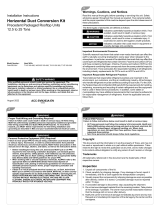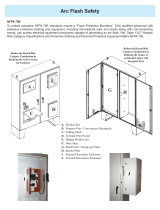
3
1
2
SAFETY WARNING
Only qualified personnel should install and service the equipment. The
installation, starting up, and servicing of heating, ventilating, and air-conditioning
equipment can be hazardous and requires specific knowledge and training.
Improperly installed, adjusted or altered equipment by an unqualified person
could result in death or serious injury. When working on the equipment, observe
all precautions in the literature and on the tags, stickers, and labels that are
attached to the equipment.
©2023
Model Number: Used With:
BAYHZCN300* E/GCC*180-300
T/YS*180-300, T/YH*180-300, T/YZ*150-300, W/D/G**180-300
Warnings, Cautions, and Notices
Read this manual thoroughly before operating or servicing this unit. Safety
advisories appear throughout this manual as required. Your personal safety
and the proper operation of this machine depend upon the strict observance of
these precautions.
Important Environmental Concerns
Scientific research has shown that certain man-made chemicals can affect the
earth’s naturally occurring stratospheric ozone layer when released to the
atmosphere. In particular, several of the identified chemicals that may affect the
ozone layer are refrigerants that contain Chlorine, Fluorine and Carbon (CFCs)
and those containing Hydrogen, Chlorine, Fluorine and Carbon (HCFCs). Not
all refrigerants containing these compounds have the same potential impact to
the environment. Trane advocates the responsible handling of all refrigerants-
including industry replacements for CFCs such as HCFCs and HFCs.
Important Responsible Refrigerant Practices
Trane believes that responsible refrigerant practices are important to the
environment, our customers, and the air conditioning industry. All technicians
who handle refrigerants must be certified according to local rules. For the USA,
the Federal Clean Air Act (Section 608) sets forth the requirements for handling,
reclaiming, recovering and recycling of certain refrigerants and the equipment
that is used in these service procedures. In addition, some states or
municipalities may have additional requirements that must also be adhered to
for responsible management of refrigerants. Know the applicable laws and
follow them.
The three types of advisories are defined as follows:
WARNING Indicates a potentially hazardous situation which, if not
avoided, could result in death or serious injury.
CAUTION Indicates a potentially hazardous situation which, if not
avoided, could result in minor or moderate injury. It
could also be used to alert against unsafe practices.
NOTICE Indicates a situation that could result in equipment or
property-damage only accidents.
WARNING
Proper Field Wiring and Grounding Required!
Failure to follow code could result in death or serious injury. All field wiring
MUST be performed by qualified personnel. Improperly installed and grounded
field wiring poses FIRE and ELECTROCUTION hazards. To avoid these
hazards, you MUST follow requirements for field wiring installation and
grounding as described in NEC and your local/state/national electrical codes.
WARNING
Personal Protective Equipment (PPE) Required!
Failure to wear proper PPE for the job being undertaken could result in death
or serious injury. Technicians, in order to protect themselves from potential
electrical, mechanical, and chemical hazards, MUST follow precautions in this
manual and on the tags, stickers, and labels, as well as the instructions below:
• Before installing/servicing this unit, technicians MUST put on all PPE
required for the work being undertaken (Examples; cut resistant gloves/
sleeves, butyl gloves, safety glasses, hard hat/bump cap, fall protection,
electrical PPE and arc flash clothing). ALWAYS refer to appropriate Safety
Data Sheets (SDS) and OSHA guidelines for proper PPE.
• When working with or around hazardous chemicals, ALWAYS refer to the
appropriate SDS and OSHA/GHS (Global Harmonized System of
Classification and Labeling of Chemicals) guidelines for information on
allowable personal exposure levels, proper respiratory protection and
handling instructions.
• If there is a risk of energized electrical contact, arc, or flash, technicians
MUST put on all PPE in accordance with OSHA, NFPA 70E, or other country-
specific requirements for arc flash protection, PRIOR to servicing the unit.
NEVER PERFORM ANY SWITCHING, DISCONNECTING, OR VOLTAGE
TESTING WITHOUT PROPER ELECTRICAL PPE AND ARC FLASH
CLOTHING. ENSURE ELECTRICAL METERS AND EQUIPMENT ARE
PROPERLY RATED FOR INTENDED VOLTAGE.
Copyright
This document and the information in it are the property of Trane, and may not
be used or reproduced in whole or in part without written permission. Trane
reserves the right to revise this publication at any time, and to make changes
to its content without obligation to notify any person of such revision or change.
Trademarks
All trademarks referenced in this document are the trademarks of their
respective owners.
Revision History
Updated Used With information on front cover.
Inspection
1. Unpack all components of the kit.
2. Check carefully for shipping damage. If any damage is found, report it
immediately, and file a claim against the transportation company.
3. Visually inspect the components for shipping damage as soon as possible
after delivery, before it is stored. Concealed damage must be reported
within 15 days.
Note: Do not attempt to repair any damaged parts until the parts are inspected
by the carrier’s representative.
WARNING
Follow EHS Policies!
Failure to follow instructions below could result in death or serious injury.
• All Trane personnel must follow the company’s Environmental, Health and
Safety (EHS) policies when performing work such as hot work, electrical, fall
protection, lockout/tagout, refrigerant handling, etc. Where local
regulations are more stringent than these policies, those regulations
supersede these policies.
• Non-Trane personnel should always follow local regulations.
April 2023 ACC-SVN170F-EN
Installation Instructions
Horizontal Economizer Conversion Kit
Packaged Rooftop Units
12.5 to 25 Tons





